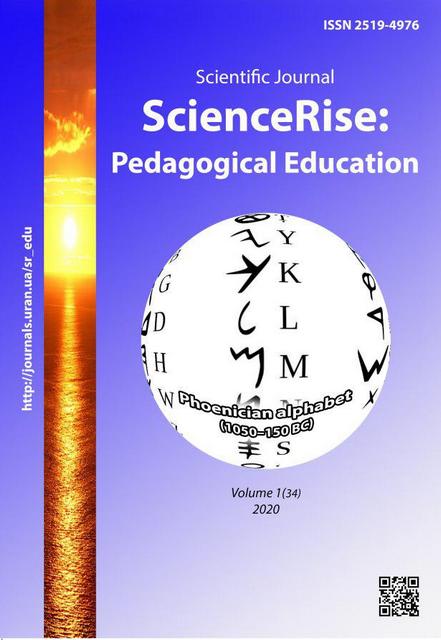Розвиток післядипломної педагогічної освіти Буковини першої половини ХХ ст.
DOI:
https://doi.org/10.15587/2519-4984.2020.192832Ключові слова:
Буковина, курси, навчальні предмети, слухачі, фахівці, фізичне виховання, форми роботиАнотація
Потреба у фахових кадрах на теренах Буковини з’явилась безпосередньо в момент становлення системи фізичного виховання школярів краю середини ХІХ ст. В змісті «Організаційного нарису гімназій та реальних шкіл в Австро-Угорський імперії», закону від 14 травня 1869 р. з’явилось офіційне визнання «тілесних вправ» як обов’язкового предмета викладання. Крім того, вагому роль в кадровому забезпеченні системи фізичного виховання Буковини відігравало розпорядження міністра віросповідань та освіти щодо вимог про порядок прийняття державних екзаменів у кандидатів на здобуття посади вчителя гімнастики (1870).
Саме нестача професійних кадрів змусила громадських активістів організовувати різноманітні форми підготовки вчителів гімнастики, інструкторів з загальної фізичної підготовки, пожежно-січової справи. В столиці краю систематично проводили «гімнастично-пожарничі» курси, в популяризації яких активно приймала участь буковинська преса. На вимогу системи фізичного виховання всіх верств населення Буковини в краї була створена процедура підготовки та підвищення кваліфікації фахівців цієї галузі. Але об’єднати всі форми підвищення кваліфікації в єдину державну систему, сформувати заклад, що відповідав вимогам часу, педагогічним положенням стало можливим лише в 40-рр. ХХ ст. Період 1938-1939 рр. став етапом становлення системи методичної роботи з керівними та педагогічними кадрами освіти УРСР. Основними складовими цієї діяльності стали: школа, кущові методичні об’єднання, педагогічні кабінети при районних відділах народної освіти, інститути удосконалення вчителів при обласних відділах народної освіти.
Основними формами післядипломної педагогічної освіти було визначено такі: курсові заходи підвищення кваліфікації; семінари і педагогічні практикуми; радіо лекції; конференції, гуртки, наради і виставки з питань обміну кращим педагогічним досвідом; загально-освітні та спеціальні навчальні екскурсії; систематичні консультації та інструктажі; розповсюдження методичних матеріалів (стенограм уроків, методичних розробок, збірників); проведення науково-дослідної роботи з класом; співпраця кращих учителів із кафедрами вищих навчальних закладів і науково-дослідних установ.
Інститут складався з дев’яти навчально-методичних кабінетів, зокрема: педагогіки, початкових класів, української і російської мови та літератури, іноземних мов, історії та географії, математики і фізики, біології й хімії, фізичної культури, позашкільного виховання
Посилання
- Oliinyk, V. V. (2012). Sohodennia ta perspektyvy rozvytku pisliadyplomnoi pedahohichnoi osvity. Postmetodyka, 4 (107), 2–6.
- Sushchenko, T. I. (2007). Kontseptsiia rozvytku pisliadyplomnoi pedahohichnoi osvity. Pisliadyplomna osvita v Ukraini, 1, 23–27.
- Ustynova, N. V. (2006). Rozvytok tvorchoho potentsialu vchytelia u systemi pisliadyplomnoi osvity. Kyiv, 24.
- Kozyr, A. V. (2016). Osnovni tendentsii rozvytku mystetskoi osvity na suchasnomu etapi. Profesionalizm pedahoha: teoretychni y metodychni aspekty, 3, 25–37.
- Kuznetsova, V. M., Shevernytska, N. M. (2017). Suchasni tendentsii mystetskoi osvity. Mystetska osvita. Visnyk KhDADM, 3, 15–19.
- Lavrinets, A. P. (2018). Modern trends of art post-graduate pedagogical education. ScienceRise: Pedagogical Education, 4 (24), 47–50. doi: http://doi.org/10.15587/2519-4984.2018.132657
- Otych, O. M. (2009). Mystetstvo u systemi rozvytku tvorchoi indyvidualnosti maibutnoho pedahoha profesiinoho navchannia: teoretychnyi i metodychnyi aspekty. Chernivtsi: Zelena Bukovyna, 752.
- Rudnytska, O. P. (2002). Pedahohika: zahalna ta mystetska. Kyiv, 270.
- Oskolov, P. V., Fedoriak, V. F., Cherkach, N. I. (2005). Korotkyi narys istorii Chernivetskoho oblasnoho instytutu pisliadyplomnoi osvity (do 65-richchia). Chernivtsi: Tekhnodruk, 62.
- Boiarska-Khomenko, A. (2019). Rozvytok pytan osvity doroslykh u pedahohichnii dumtsi Avstrii. Pedahohichni nauky, 86, 18–22.
- Tymchuk, L. I. (2015). Systema osvity doroslykh v Ukraini (50–80-ti roky XX st.). Osvita doroslykh: teoriia, dosvid, perspektyvy, 1 (10), 123–134.
- Egetenmeyer, R. (2016). Adult Education and Lifelong Learning in Europe and Beyond. Comparative Perspectives from the 2015 Würzburg Winter School. Frankfurt am Main, Berlin, Bern, Bruxelles, New York, Oxford, Wien, 276. doi: http://doi.org/10.3726/978-3-653-05973-1
- Tsybaniuk, O. (2008). Upravlinnia systemoiu fizychnoho vykhovannia shkoliariv na Bukovyni (druha polovyna XX – pochatok XX stolittia). Ivano-Frankivsk, 265.
- Dariichuk, C. V. (2018). Tilovykhovna ta zdorovʼyazberihaiucha tematyka sotsial-demokratychnoi presy Bukovyny pochatku XX st. Sotsialno-humanitarni nauky ta suchasni vyklyky. Dnipro: Dniprovskyi natsionalnyi universytet, 277–280.
- Yachniuk, I. (2015). Istorychni etapy profesiinoi pidhotovky vchyteliv fizychnoi kultury na Bukovyni. Istorychni, filosofski, pravovi y kadrovi problemy fizychnoi kultury, 23–26.
- Himnastychno-pozharnychyi kurs (1908). Narodna sprava. Chernivtsi, 22-23, 9.
- Zapomohy dlia Sichei (1909). Hromadianyn. Chernivtsi, 4.
- Kurs pozharnycho-himnastychnyi «Soiuza Sichei» na Bukovyni. Hromadianyn, 2.
- Sichovi visti (1909). Hromadianyn. Chernivtsi, 21-22, 4.
- Instytut pisliadyplomnoi pedahohichnoi osvity Chernivetskoi oblasti: daty, podii, postati. Z nahody 75-littia vid chasu zasnuvannia (2015). Chernivtsi, 276.
##submission.downloads##
Опубліковано
Як цитувати
Номер
Розділ
Ліцензія
Авторське право (c) 2020 Oleksandra Tsybaniuk

Ця робота ліцензується відповідно до Creative Commons Attribution 4.0 International License.
Наше видання використовує положення про авторські права Creative Commons CC BY для журналів відкритого доступу.
Автори, які публікуються у цьому журналі, погоджуються з наступними умовами:
1. Автори залишають за собою право на авторство своєї роботи та передають журналу право першої публікації цієї роботи на умовах ліцензії Creative Commons CC BY, котра дозволяє іншим особам вільно розповсюджувати опубліковану роботу з обов'язковим посиланням на авторів оригінальної роботи та першу публікацію роботи у цьому журналі.
2. Автори мають право укладати самостійні додаткові угоди щодо неексклюзивного розповсюдження роботи у тому вигляді, в якому вона була опублікована цим журналом (наприклад, розміщувати роботу в електронному сховищі установи або публікувати у складі монографії), за умови збереження посилання на першу публікацію роботи у цьому журналі.









